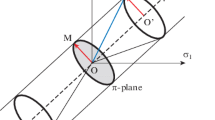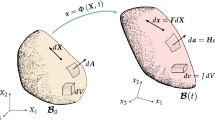Abstract
This paper describes research on the prediction of necking and failure in metals at very high strain rates. The model developed in this paper uses a total Lagrangian SPH formulation with a normalised kernel. The detailed data from electromagnetically driven ring experiments by Zhang and Ravi-Chandar (Int J Fract 142:183–217, 2006) is used to evaluate the accuracy of the model predictions. In order to correctly model fracture in the total Lagrangian SPH formulation a visibility criterion based on a truncated cone has been implemented to remove particles obscured by a failed particle. A Johnson-Cook plasticity model is used in combination with a Lemaitredamage model to describe the plastic deformation and fracture of the rings. The effect of Joule heating due to the current induced in the ring is taken into account in the constitutive model. The acceleration due to the ring currents was implemented in the SPH code as a body force. The results demonstrate that this type of model is capable of predicting the number of fragments as well as the time of fracture. In agreement with experimental data, the model also predicts arrested necks and bending in the fragments.





















Similar content being viewed by others
References
Becker R (2002) Ring fragmentation predictions using the Gurson model with material stability conditions as failure criteria. Int J Solids Struct 39:3555–3580
Belytschko T, Xiao SP (2000) Stability analysis of particle methods with corrected derivatives. Comput Math Appl 43: 329–350
Corbett BM (2006) Numerical simulations of target hole diameters for hypervelocity impacts into elevated and room temperature bumpers. Int J Impact Eng 33:431–440
Dong Q, Thomas E, Shaofan L, Wing Kam L (2008) Meshfree simulation of failure modes in thin cylinders subjected to combined loads of internal pressure and localised heat. Int J Numer Methods Eng 76:1159–1184
Fyfe JM, Rajendran AM (1979) Dynamic pre-strain and inertia effects on the fracture of metals. J Mech Phys Solids 28:17–26
Grady DE, Benson DA (1983) Fragmentation of metal rings be electromagnetic loading. Exp Mech 23:393–400
Guduru PR, Freund LB (2002) The dynamics of multiple neck formation and fragmentation in high rate extension of ductile materials. Int J Solids Struct 39:5615–5632
Hiroe T, Fujiwara K, Hata H, Takahashi H (2008) Deformation and fragmentation behaviour of exploded metal cylinders and the effects of wall materials configuration, explosive energy and initiated locations. Int J Impact Eng 35:1578–1586
Hopson MV, Scott CM, Patel R (2011) Computational comparisons of homogeneous and statistical descriptions of AerMEt100 steel subjected to high strain rate loading. Int J Impact Eng 38:451–455
Hu X, Daehn GS (1996) Effect of velocity on flow localisation on tension. Acta Mater 44(3):1021–1033
Johnson JN (1981) Dynamic fracture and spallation in ductile solids. J Appl Phys 52(4):2812–2824
Landen D, Wetz D, Satapathy S, Levinson S (2009) Electromagnetically driven expanding ring with preheating. IEEE Trans magn 45:598–603
Lemaitre J, Chaboche JL (1990) Mechanics of solid materials. Cambridge University Press, Cambridge
Lemaitre J, Sermage JP (1997) One damage law for different mechanisms. Comput Mech 20:84–88
LSTC (2007) LS-Dyna keyword user’s manual, version 971, volume I and II. LSTC, Livermore, California
Meulbroek JP, Ramesh KT, Swaminathan PK, Lennon AM (2008) CTH simulations of an expanding ring to study fragmentation. Int J Impact Eng 35:1661–1665
Meyer HW Jr, Brannon RM (2012) A model for statistical variation of fracture properties in a continuum. Int J Impact Eng 42:48–58
Meyers MA (1994) Dynamic behavior of materials. Wiley, New York
Mercier S, Molinari A (2004) Analysis of multiple necking in rings under rapid radial expansion. Int J Impact Eng 30: 403–419
Mercier S, Granier N, Molinari A, Llorca F, Buy F (2010) Multiple necking during the dynamic expansion of hemispherical metallic shells, from experiments to modelling. J Mech Phys Solids 58:955–982
Pandolfi A, Krysl P, Ortiz M (1999) Finite Element simulation of ring expansion and fragmentation: the capturing of length and time scales through cohesive models of fracture. Int J Fract 95:279–297
Rabczuk T, Belytschko T, Xiao SP (2004) Stable particle methods based on Lagrangian kernels. Comput Methods Appl Mech Eng 193:1035–1063
Rabczuk T, Belytschko T (2004) Cracking particles: a simplified meshfree method for arbitrary evolving cracks. Int J Numer Methods Eng 61:2316–2343
Randles PW, Libersky LD (1996) Smoothed particle hydrodynamics: some recent improvements and applications. Comput Methods Appl Mech Eng 139:375–408
Rusinek A, Zaera R (2007) Finite element simulation of steel ring fragmentation under radial expansion. Int J Impact Eng 34:799–822
Satapathy S, Landen D (2006) Expanding ring experiments to measure high-temperature adiabatic properties. Int J Impact Eng 33:735–744
Shenoy VB, Freund LB (1999) Necking bifurcations during high strain rate extension. J Mech Phys Solids 47:2209–2233
Sørensen NJ, Freund LB (2000) Unstable neck formation in a ductile ring subjected to impulsive radial loading. Int J Solids Struct 37:2265–2283
Swegle JW, Hicks DL, Attaway SW (1995) Smoothed particle hydrodynamics stability analysis. J Comp Phys 116:123–134
Triantafyllidis N, Waldenmyer JR (2004) Onset of necking in electro-magnetically formed rings. J Mech Phys Solids 52:2127–2148
Vadillo G, Rodriguez Martinez JA, Fernandez Saez J (2012) On the interplay between strain rate and strain rate sensitivity on flow localisation in the dynamic expansion of ductile rings. Int J Solids Struct 49:481–491
Vignjevic R, Reveles JR, Campbell J (2006) SPH in a total lagran- gian formalism. CMES Comput Model Eng Sci 14(3):181–198
Vignjevic R, Campbell J, Jaric J, Powell S (2009) Derivation of SPH equations in a moving referential coordinate system. Comp Methods Appl Mech Eng 198(30–32):2403–2411
Zhang H, Ravi-Chandar K (2006) On the dynamics of necking and fragmentation—I. Real-time and post-mortem observations in Al 6061-O. Int J Fract 142:183–217
Zhang H, Ravi-Chandar K (2008) On the dynamics of necking and fragmentation—II. Effect of material properties, geometrical constraints and absolute size. Int J Fract 150:3–36
Zhang H, Ravi-Chandar K (2009) On the dynamics of necking and fragmentation—III. Effect of cladding with a polymer. Int J Fract 155:101–118
Zhang H, Ravi-Chandar K (2009) On the dynamics of necking and fragmentation—IV., Expansion of Al 6061-O tubes. Int J Fract 163:41–65
Zhang H, Ravi-Chandar K (2009) Dynamic fragmentation of ductile materials. J Phys D: Appl Phys 42(21):1–16
Zhou F, Molinari JF, Ramesh KT (2006) Analysis of the brittle fragmentation of an expanding ring. Comput Mater Sci 37: 74–85
Zhou F, Molinari JF, Ramesh KT (2006) An elastic-visco-plastic analysis of ductile expanding ring. Int J Impact Eng 33: 880–891
Author information
Authors and Affiliations
Corresponding author
Rights and permissions
About this article
Cite this article
De Vuyst, T., Vignjevic, R. Total Lagrangian SPH modelling of necking and fracture in electromagnetically driven rings. Int J Fract 180, 53–70 (2013). https://doi.org/10.1007/s10704-012-9801-4
Received:
Accepted:
Published:
Issue Date:
DOI: https://doi.org/10.1007/s10704-012-9801-4




